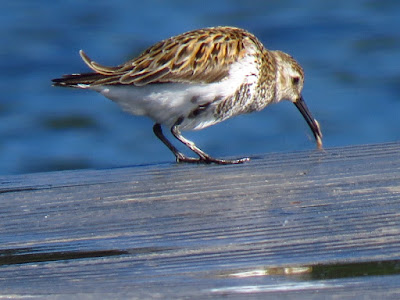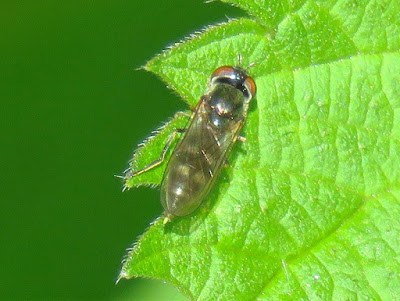7.0°C > 11.0°C: Mostly clear start; a few puffy clouds later later. Brisk-feeling W breeze. Excellent visibility.
Sunrise: 05:07 BST
* = a photo today
Priorslee Lake: 04:15 – 05:55 // 06:50 – 09:00 again
(96th visit of the year)
A very rare occurrence today: two species of wader at the same (or almost) time:
- While doing litter-picking on the dam-face I flushed a Little Ringed Plover. Could it be the same bird as seen Sunday? And is it perhaps nesting nearby? When displaying this species is very noisy and unlikely to be overlooked.
- When I walked back to the W end I was careful in case the LRP was on the SW grass. I espied a small wader on one of the Sailing Club boating platforms but it turned out to be a Dunlin almost in to full summer plumage. A species I have not recorded here for at least seven years. 1 August 1991 was my first. The only other record I specifically recall was four birds unexpectedly arriving one winter's day while a group of us were puzzling over what turned out to be a Ringed-bill x Lesser Black-backed Gull hybrid. That was at least 10 years ago. Species #100 this year here for me.
Other bird notes:
- Yesterday's two very new juvenile Coots from a fifth brood seen again; also two from a sixth brood.
- Now only two Great Crested Grebes!
- *The immature Herring Gull and two Lesser Black-backed Gulls were dive-bombing a Common Buzzard overhead.
- The Sedge Warbler seems to have gone.
Overhead:
- 2 Greylag Geese: pair outbound
- 3 (2♂) Tufted Duck: flew E together
- 3 Feral Pigeons: together
- 2 Stock Doves: together
- 9 Wood Pigeons
- *1 Herring Gull: immature
- 7 Lesser Black-backed Gulls: four (near) adults; three immatures
- 5 Cormorants (single and quartet)
- *2 Common Buzzards: separately
- 59 Jackdaws
- 8 Rooks
Hirundines etc., noted:
- 3 Swifts
- 4 Barn Swallows again
Warblers noted (the number in brackets is singing birds):
- 13 (12) Chiffchaffs
- no Sedge Warbler
- 10 (10) Reed Warblers
- 16 (14) Blackcaps
- 6 (5) Garden Warblers
- 4 (3) Common Whitethroats
Count from the lake area
- 2 + 5 (1 brood) Canada Geese
- 2 + 7 (1 brood) Mute Swans
- 4 (4♂) Mallard
- 2 Moorhens again yet again
- 22 + 4 (2 broods) Coots
- 1 Little Grebe: heard only
- 2 Great Crested Grebes only
- 1 Little Ringed Plover
- *1 Dunlin
- 1 Grey Heron
On / around the street lamps pre-dawn:
Nothing
Noted later:
Butterflies:
- *Green-veined White (Pieris napi)
Moths:
- Common Nettle-tap (Anthophila fabriciana): moth species #13 for the year
Bees / Wasps etc.:
- Common Carder Bee (Bombus pascuorum)
- *Early Bumblebee (Bombus pratorum)
- Common Wasp (Paravespula vulgaris)
Hoverflies:
- Plain-faced Dronefly (Eristalis arbustorum)
- Tapered Dronefly (Eristalis pertinax)
- Blotch-winged Hoverfly (Leucozona lucorum)
- *Chequered Hoverfly (Melanostoma scalare)
- *White-footed Hoverfly (Platycheirus albimanus)
- Syrphus sp.
- *Green-veined White (Pieris napi)
Moths:
- Common Nettle-tap (Anthophila fabriciana): moth species #13 for the year
Bees / Wasps etc.:
- Common Carder Bee (Bombus pascuorum)
- *Early Bumblebee (Bombus pratorum)
- Common Wasp (Paravespula vulgaris)
Hoverflies:
- Plain-faced Dronefly (Eristalis arbustorum)
- Tapered Dronefly (Eristalis pertinax)
- Blotch-winged Hoverfly (Leucozona lucorum)
- *Chequered Hoverfly (Melanostoma scalare)
- *White-footed Hoverfly (Platycheirus albimanus)
- Syrphus sp.
Other 'flies':
- *Scorpion Fly (Panorpa sp.): see note 2 below
- Alder Fly (Sialis lutaria)
- *The cranefly Tipula lateralis
- *Scorpion Fly (Panorpa sp.): see note 2 below
- Alder Fly (Sialis lutaria)
- *The cranefly Tipula lateralis
Earwigs:
- *Common Earwig (Forficula dentata): see note 2 below
- *Common Earwig (Forficula dentata): see note 2 below
Bugs:
- *Dock Bug (Coreus marginatus)
- *Dock Bug (Coreus marginatus)
Molluscs
- White-lipped Snail (Cepaea hortensis)
Spiders
- Stretch spider sp (Tetragnatha sp.)
Notes:
1. Scorpion flies are not true flies but in the order Neuoptera with lacewings.
2. Recent research has redefined the Common or European Earwig (was Forficula auricularia) as four largely cryptic species. Those occurring in the UK (and near Continent) have seen ascribed to F. dentata. Vernacular names were not proposed in the scientific paper so I have used 'Common Earwig'.
Thanks again to the Shropshire Spider Recorder yesterday's unidentified spider is in the stretch spider family but within the genus Metellina, probably M segmentata. Microscopic examination is needed to be certain.
In summer they look very different from the mainly grey birds along estuaries in winter. Rufous edges and white tips to the black-centred back feathers.
- White-lipped Snail (Cepaea hortensis)
Spiders
- Stretch spider sp (Tetragnatha sp.)
Notes:
1. Scorpion flies are not true flies but in the order Neuoptera with lacewings.
2. Recent research has redefined the Common or European Earwig (was Forficula auricularia) as four largely cryptic species. Those occurring in the UK (and near Continent) have seen ascribed to F. dentata. Vernacular names were not proposed in the scientific paper so I have used 'Common Earwig'.
Thanks again to the Shropshire Spider Recorder yesterday's unidentified spider is in the stretch spider family but within the genus Metellina, probably M segmentata. Microscopic examination is needed to be certain.
The first decent sunrise for a while this morning. Just starting.
Colouring up a bit.
The long view.
And later after the colour had gone.
A Dunlin well in to summer plumage when the belly becomes all black.
In summer they look very different from the mainly grey birds along estuaries in winter. Rufous edges and white tips to the black-centred back feathers.
Best foot forward! There are a number of different races of Dunlin which with experience and practice can be separated on bill length, though that is complicated in that females average longer bills than males. I do not aspire to be able to do this.
And it has found a morsel.
Another 'long range special', The upper bird with pale showing around the ends of the inner primaries is an immature Herring Gull. It and two Lesser Black-backed Gulls were rather upset at the presence of the Common Buzzard.
My first Green-veined White butterfly (Pieris napi) of the year - species #6 here. Always easier to identify from the very prominent veins on the underside of, especially, the hindwing. Main confusion species is Small White (P rapae) though that is not quite as Daz white (showing my age? Oxydol anyone?).
This bumblebee is rather scruffy-looking but too yellow to be a Common Carder Bee (Bombus pascuorum). It is an Early Bumblebee (Bombus pratorum).
Compare and contrast time. This is the most common small hoverfly at the moment: Chequered Hoverfly (Melanostoma scalare). Note the yellow markings on the abdomen just about visible through the folded wings.
And here a White-footed Hoverfly (Platycheirus albimanus) with grey or silver marking almost equally well hidden by the folded wings.
A female Scorpion Fly (Panorpa sp.) - the male has the genitals that resemble a scorpion's tail. There are two species of scorpion fly that are common in the UK and I used to separate them. I now learn that the wing spotting is an unreliable guide to the specific identity. Microscope again.
This cranefly is Tipula lateralis. It is unusual for a crane-fly in having a pale line down the centre of the abdomen. The combination of this with the dark veins in the wings makes ID easy.
A Common Earwig (now Forficula dentata) as noted in the text.
I am sure there some evolutionary explanation for the shape of this Dock Bug (Coreus marginatus) and also as to why a brown insect is sitting on a green leaf. Strange 'bent' antennae.
This area (among others) was mown just yesterday within an inch of its life. Seems that Telford and Wrekin Council do not subscribe to the RSPB's suggestion of 'no mow May' to allow all the wildflowers to bloom and our threatened insects to thrive. As far as the council are concerned - 'weeds'. As far as the contractors who do the mowing are concerned - 'money'. The council could save money by reducing the frequency of mowing. There can be no safety issue here.
Between the lake and The Flash
- Just the sitting adult Moorhens on nests at each pool.
- no Chiffchaff seen or heard.
- 2 Blackcaps calling just above the upper pool.
The Flash: : 06:00 – 06:45 again
(Ed Wilson)
------------------------------------------------------------------------------------------------------
- Just the sitting adult Moorhens on nests at each pool.
- no Chiffchaff seen or heard.
- 2 Blackcaps calling just above the upper pool.
(Ed Wilson)
------------------------------------------------------------------------------------------------------
(83rd visit of the year)
Bird notes:
- *A pair of Mallard with three ducklings. Could this be the same three last seen on Saturday?
- Just two pairs of Tufted Duck.
- Seems I was mistaken yesterday: there are still two juvenile Coots in the nest along the W side. Again none was seen peering out under the brooding adult in the nest by the bridge.
Birds noted flying over here:
- 2 Jackdaws
Hirundines etc. noted:
None
Warblers noted (the number in brackets is singing birds):
- 2 (2) Chiffchaffs
- 4 (3) Blackcaps
On /around the water:
- 28 Canada Geese
- 7 Greylag Geese: two of these arrived
- 3 + 4 (1 brood) Mute Swan
- *22 (15♂) + 3 (1 brood) Mallard
- 4 (2♂) Tufted Duck
- 4 Moorhens
- ?? + 2 (1 brood) Coots
Otherwise noted:
- 1 Grey Squirrel
- 2 (2) Chiffchaffs
- 4 (3) Blackcaps
On /around the water:
- 28 Canada Geese
- 7 Greylag Geese: two of these arrived
- 3 + 4 (1 brood) Mute Swan
- *22 (15♂) + 3 (1 brood) Mallard
- 4 (2♂) Tufted Duck
- 4 Moorhens
- ?? + 2 (1 brood) Coots
Otherwise noted:
- 1 Grey Squirrel
A Nuthatch arrives at the nest-hole with food.
(Ed Wilson)
------------------------------------------------------------------------------------------------------
On this day
2020
Priorslee Lake
Today's Sightings Here
2019
Priorslee Lake
Today's Sightings Here
2016
Priorslee Lake
Today's Sightings Here
2015
Priorslee Lake
Today's Sightings Here
2014
Priorslee Lake
Today's Sightings Here
2013
Priorslee Lake
Curlew
Grasshopper Warbler
(Ed Wilson)
Wrekin
5 Tree Pipits
2 Common Redstart
2 Spotted Flycatchers
5 Pied Flycatcher
5 Wood Warblers
Tawny Owl
(Ed Wilson)
2012
Priorslee Lake
Grasshopper Warbler
(Ed Wilson)
Wrekin
21 Crossbill
4 Wood Warbler
Pied Flycatcher
Common Redstart
Tree Pipit
(Glenn Bishton)
2006
Priorslee Lake
2 Ruddy Ducks
(Ed Wilson)



















